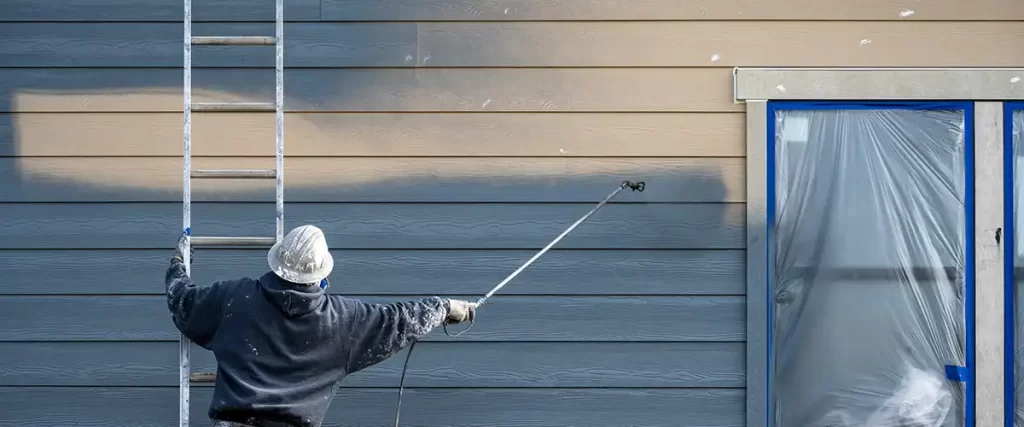You can paint in direct sunlight, but it’s usually not your best move. Strong sun and high air temperatures rush surface drying, overheat the substrate, and disrupt film formation. The result: lap marks, blisters, early color fade, and a finish that won’t go the distance.
Quick guide:
- Best window: 50–85°F (10–29°C), moderate humidity, surface temp under ~90°F (32°C), and out of direct sun.
- Skip it when: the surface is hot to the touch, the sun is hitting hard, wind is whipping, or humidity is extremely low/high.
- If sun is unavoidable: work the shaded side and follow the shade, use a pop-up canopy or shade cloth, let hot surfaces cool, add a manufacturer-approved extender for more open time, and paint smaller sections to keep a wet edge.
- Why it matters: paint needs time to level and bond; fast drying ≠ better curing, and that’s where durability is lost.

Why Sunlight Causes Trouble
Sunlight changes how fast paint can dry, and factors like type of paint and high humidity make those issues worse.
1. Heat = Rapid Surface Drying
On hot, sunny days, the surface skins over before the underlayer levels out. The solvents and moisture inside can evaporate too quickly, leading to:
- Lap marks & brush drag (you can’t maintain a wet edge)
- Flashing (uneven sheen)
- Solvent pop or pinholing in certain coatings
- Improper flow (rapid drying prevents the paint from leveling properly, causing streaks or uneven coverage)
2. UV = Color Fade & Binder Breakdown
UV light breaks down pigments and binders, especially in darker colors that absorb more heat. That means:
- Faster color fading
- Early chalking (that powdery residue on your hand)
- Reduced protection against weather and moisture
To minimize fading and binder breakdown, choose a high-quality exterior paint specifically formulated for UV resistance.
3. Trapped Moisture = Blistering & Peeling
When the surface gets hot fast, water or solvents try to escape. If the top film has already skinned, the paint can blister, bubble, and eventually peel. Fresh paint is especially susceptible to blistering and peeling if exposed to rapid heating or moisture during the initial drying phase.
Does Paint Dry Faster in the Sun?
Yes, but faster isn’t better. A paint job needs controlled evaporation for paint to dry and cure properly. Sun pushes the timeline, so you trade a quicker “dry-to-touch” for weaker adhesion, rougher texture, and shorter life.
Ideal Conditions (Exterior)
- Air temp: 50–85°F (10–29°C)
- Surface temp: ideally below 90°F (32°C)
- Humidity: low humidity is ideal for best results (roughly 40–70%)
- Wind: light (strong wind also speed-dries the film)
- Sun: work in shade or filtered light
Always check your specific paint’s label, manufacturers give a temp/humidity window for best results. Ideal temperatures and weather conditions for painting outdoors keep the paint from drying too fast or unevenly.

If You Must Paint in Direct Sunlight
When you plan to paint outdoors, always consider the weather and time of day to achieve the best results.
1. Chase the shade. Start on the west side in the morning and move to the east side in the afternoon. The orientation of your house affects which areas are shaded at different times, so plan your work accordingly. North and shaded elevations are your best friends at midday.
2. Cool the surface. If a wall or door is hot to the touch, let it cool. Shade it with a pop-up canopy or shade cloth. (Avoid spraying water right before painting. Damp substrates can cause blistering.)
3. Use the right additives. For water-based paints, a drying extender/retarder (per the label) gives you more open time so you can keep a wet edge. Don’t over-thin.
4) Work smaller sections. Cut in and roll smaller panels so edges don’t set before you blend them. Keep a steady pace and maintain a wet edge.
5) Choose forgiving tools. High-quality roller covers and brushes hold more paint and release it smoothly, helping with leveling in warmer conditions.
6) Watch for hot surfaces. Metal doors and trim can exceed 120°F (49°C) in sun. If you can, remove and paint in the shade. Otherwise, wait until the surface cools.
Even a professional painter follows these guidelines when they paint outdoors to ensure a smooth, long-lasting finish and to avoid common problems.
Product & Color Choices That Help in the Sun
The right type of paint and color performs better at the proper temperature to paint outside and resists fading in direct sun.
- 100% acrylic exterior paints offer superior UV resistance and durability.
- Lighter colors reflect more heat and fade more slowly.
- Look for coatings marketed as UV-resistant, high-solids, or cool/reflective for sunnier elevations.
- Satin and semi-gloss sheens tend to weather and wash better on trim and high-touch areas.
Common Sun-Caused Defects & Fixes
When weather conditions for painting aren’t met, the paint may dry poorly and lead to common defects.
Blistering/Peeling
- Why it happened: trapped moisture/solvents, hot substrate. Painted surfaces exposed to direct sun are more likely to develop these defects.
- Fix: scrape to sound paint, sand, spot-prime bare areas, repaint in shade within spec temps.
Chalking
- Why it happened: binder degraded by UV.
- Fix: wash thoroughly until chalk is gone (test with a fingertip), let dry, apply a bonding or appropriate primer, then repaint.
Lap Marks/Flashing
- Why it happened: paint skinned over too fast.
- Fix: after full cure, a uniform recoat in shade (with extender) usually evens it out.

Exterior Timing Tips (Especially Useful Around Wichita)
- Spring and fall usually offer the best combo of temps and humidity, as both extreme heat and cold should be avoided for best painting results.
- In summer, plan morning and late afternoon shifts, avoiding midday sun on south and west faces.
- Watch the dew point and overnight temps. Painting too late can invite condensation before the film sets.
Interior Note: Sun Through Windows
Even indoors, direct sun streaming through glass can overheat a surface. If you’re painting in the sun inside, close blinds, hang a temporary shade, or paint that wall when the sun has moved on.
Safety Precautions When Painting in Sunlight
Painting outdoors in direct sunlight isn’t just tough on your paint job. It can also take a toll on you. Whether you’re tackling an exterior painting project or just touching up a few spots, keeping safety front and center is key to a successful outcome.
Time your painting wisely. The best move is to start painting in the early morning or late afternoon, when the sun is less intense and surface temperatures are cooler. This helps prevent freshly applied paint from drying too quickly, which can lead to poor adhesion and an uneven finish. Avoid painting during the hottest part of the day, especially in hot weather or extreme temperatures.
Dress for protection. Direct sunlight can wreak havoc on your skin and eyes. Wear a wide-brimmed hat, UV-blocking sunglasses, and plenty of sunscreen to protect yourself from sunburn. Lightweight, long-sleeved shirts and pants can also help shield your skin while you work.
Stay hydrated and take breaks. Painting outdoors in the sun means you’ll be losing more fluids than you think. Keep a water bottle handy and take regular breaks in the shade to avoid heat exhaustion. If you start feeling dizzy or overheated, stop immediately and cool down.
Monitor surface temperatures. Use an infrared thermometer to check the temperature of exterior surfaces before you apply paint. Most latex paints and oil based paints perform best within an optimal temperature range, usually between 60°F and 85°F. Painting outside of this range can cause paint failure, so always check before you start.
Choose the right tools and techniques. For a smooth, professional-looking finish, use high-quality brushes or rollers and apply paint in thin, even coats. This helps prevent brush marks and ensures the paint dries evenly, even when painting outdoors. Avoid overloading your brush or roller, as too much paint can lead to drips and an uneven finish.
Watch the weather. High winds, rain, or sudden changes in weather conditions can ruin even the best-laid painting plans. If the forecast calls for rain or strong winds, it’s best to postpone your painting project. Always avoid painting in extreme temperatures or when the weather is unpredictable.
Follow product safety guidelines. Whether you’re using latex paints or oil based paints, always read and follow the manufacturer’s instructions for safe use. Some based paints can cause skin or eye irritation, so wear gloves and eye protection as needed.
Know when to call in the pros. If you’re unsure about any part of the painting process, don’t hesitate to reach out to professional painters. Their expertise can help you avoid costly mistakes and ensure your exterior painting project stands up to sun, heat, and time.
By following these safety tips, you’ll protect yourself and your paint job. Ensuring your exterior painting looks great and lasts, no matter how bright the summer sun gets.

FAQ: Painting in the Sun
Can you paint in direct sunlight?
You can, but you’ll get a longer-lasting, better-looking finish by painting in shade or filtered light.
Does paint dry faster in the sun?
Yes, often too fast, which leads to defects and weaker adhesion.
What temperature is too hot to paint?
Follow your label, but generally avoid painting when the surface is above ~90°F (32°C).
Is morning or afternoon better?
Depends on the elevation. Paint the shaded sides, typically the west side in the morning and the east side later. So you’re not painting in direct sunlight.
How do I know if a wall is too hot?
If you can’t keep your hand on it for 5–10 seconds, it’s too hot. An IR thermometer is even better.
The Bottom Line
Can you paint in the sun? Yes. Should you? Only when heat and light are tightly controlled. A durable exterior isn’t guesswork. It’s sequencing elevations with the sun’s path, checking surface temps, watching dew point and wind, choosing UV-stable systems, and using extenders so the film levels instead of skinning.
If you’re considering exterior painting, we can take the guesswork out of it. Our team handles the details that make a difference: cooling hot surfaces, maintaining a wet edge, and choosing coatings that won’t fade or peel after one season.
Call us at (316)-800-6994 or message us here. We’ll walk the exterior with you, map the sun strategy, and provide a clear, written quote.
